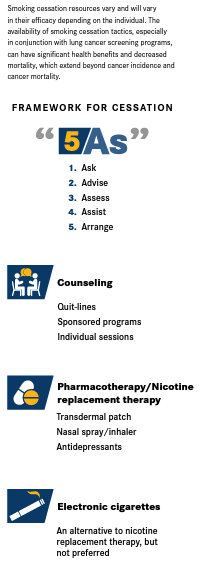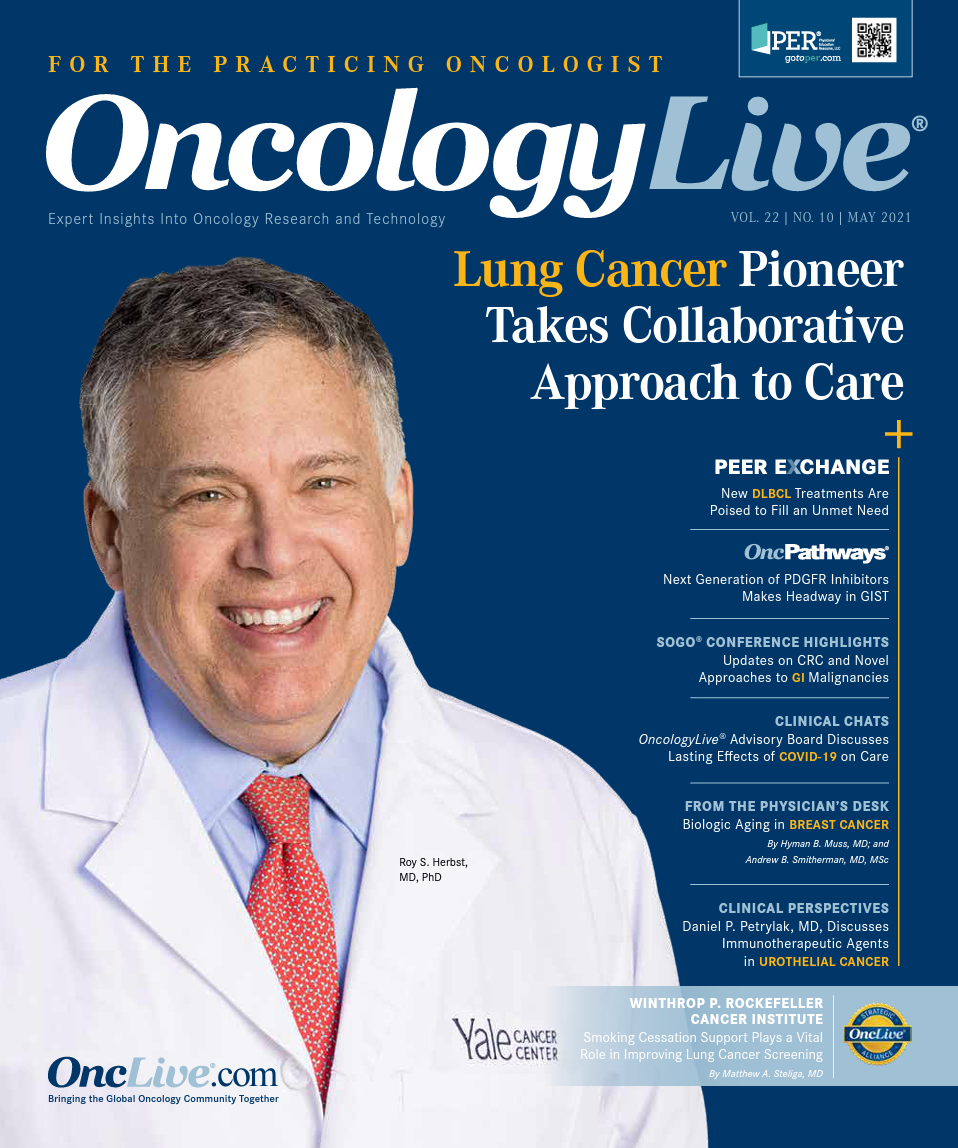Smoking Cessation Support Plays a Vital Role in Improving Lung Cancer Screening
Results of the National Lung Screening Trial demonstrated a 20% decrease in lung cancer mortality in individuals aged 55 to 74 years with a 30 pack-year smoking history using a low-dose computed tomography scan.
Matthew A. Steliga, MD

Results of the National Lung Screening Trial (NLST) demonstrated a 20% decrease in lung cancer mortality in individuals aged 55 to 74 years with a 30 pack-year smoking history using a low-dose computed tomography scan (LDCT).1 These data marked a turning point that led to the development of LDCT screening programs throughout the world. Many individuals undergoing screening are current smokers, which puts them at additional risk of developing a host of other diseases, so cessation at any point is beneficial.
Counseling and pharmacotherapy are effective evidence-based strategies, but many current smokers do not receive this support. We must recognize that the overarching goal of any cancer screening program is not merely to diagnose more cases or deliver more treatment but, ultimately, to help patients live longer, better lives.
Smoking in the Screened Population
The incidence of lung cancer even in this high-risk group undergoing screening is typically less than 2%. An overlooked and undertreated risk factor in patients undergoing screening for lung cancer is the very same one that makes them eligible for screening—smoking. Baseline demographics in the NLST indicated that 48.1% (n = 26,722) were current smokers at the time of enrollment.1
Data from the University of Arkansas2 demonstrated that 70.2% (n = 309/440) of individuals undergoing LDCT were current smokers. Data have demonstrated that screen-detected abnormal LDCT findings were associated with increased cessation rates3 and, importantly, that normal scans were not associated with increased smoking or relapse in individuals who had quit.
In summary, the screened group evaluated for lung cancer may have a relatively low incidence of lung cancer, but often patients present with treatable conditions that are otherwise not optimally addressed.
Benefits of Cessation
Tobacco cessation may be viewed by many with the nihilistic perspective that “quitting now won’t make any difference” or “those individuals don’t want to quit.” In actuality, most individuals who smoke do want to quit, and quitting at any point has significant benefits, especially following a diagnosis of cancer.4,5
In findings from NLST, 24.1% (n = 930/3856) died of lung cancer. Interestingly, more individuals died because of cardiovascular disease (24.8%; n = 956/3856). In addition, 22.3% died because of other neoplasms, and 10.4% died of respiratory illnesses.1
The majority of the deaths in NLST were because of tobacco-related diseases, with lung cancer representing less than a quarter of the overall deaths.1 We know that quitting smoking decreases cardiovascular risk, cerebrovascular events, and respiratory diseases; thus, if we wish to affect mortality rates through LDCT programs, detection and treatment of lung cancer are only part of the solution.
The National Comprehensive Cancer Network guidelines for lung cancer screening6 recommend that all current smokers be advised to quit. The degree to which individual programs advise patients can range widely. At minimum, patients may receive a verbal recommendation, print material, or a phone number for a quit-line.
A Cochrane review of smoking cessation concluded that a recommendation from a physician alone can increase cessation an additional 1% to 3%.7 Although physician advice does boost rates of quitting over offering no advice, there is room for improvement— and a structured program with counseling support and pharmacotherapy could potentially raise this rate several fold.
Mainstays of Cessation
The details of evidence-based cessation support cannot be thoroughly covered in a brief perspective, but 2 broad categories include counseling and pharmacotherapy.
Counseling may include telephone counseling in the form of a quit-line, online counseling, group counseling programs, and individual counseling. Pharmacotherapy consists of nicotine replacement therapy, varenicline, or bupropion. More in-depth discussion of this is highlighted in other works.8 Much as we do not have the space to detail nuances of how to counsel patients, leaders overseeing lung screening programs do not have adequate time or expertise to counsel patients and deliver cessation support. This reinforces the criticality of having those in the LDCT workflow capable of providing this effective support.
The program at Winthrop P. Rockefeller Cancer Institute at University of Arkansas for Medical Sciences is run by an advanced practice registered nurse (APRN) who coordinates a team of APRNs and others with a background in tobacco cessation. The arrangements for the scan, follow-up calls for the results, and future contact are carried out by a member of our lung cancer team who is equipped with skills and time to provide counseling for cessation.
As we built and grew our program, cessation counseling was always a part of the care delivered, and the integration facilitated delivery.
Figure. Hallmarks of Smoking Cessation1

Opt-Out Strategy
Different programs have varying types of support, but regardless of the method, efficacy requires acceptance by the patient. Our early experience9 involved offering each patient an opportunity to visit with a counselor. By framing the visit as a choice, many patients declined.
Reframing cessation as an opt-out strategy led to presenting the patient with a message such as: “While you are here, we’re going to discuss smoking as a standard part of our program.” This shift led to most patients meeting with counselors face to face. Cancer Care Ontario demonstrated that structuring its smoking cessation program as an opt-out model led to 88% of individuals being offered a baseline LDCT attending a hospital-based counseling session.10
Regardless of the cessation resources used in a screening program, an opt-out strategy will likely have greater acceptance to patients and greater efficacy.
Conclusions
Lung cancer screening programs contain a high proportion of patients with a heavy smoking history who are unable to quit but may be receptive to support during this teachable moment. For example, if an LDCT program has a participation with a 50% smoking rate among individuals enrolled, consider that unaided cessation is approximately 2%. Rates for those individuals who receive cessation support with the addition of programs such as intensive telephone counseling and nicotine replacement therapy is approximately 20%, therefore it is reasonable to expect that the number of patients helped with smoking cessation could easily eclipse the number diagnosed and treated for cancer.8,11
Overall, smoking cessation may broaden the effect of lung cancer screening programs well beyond end points of cancer diagnosis and cancer mortality rates— helping even more of our patients lead longer, healthier lives.
References
- National Lung Screening Trial Research Team; Aberle DR, Adams AM, Berg CD, et al. Reduced lung-cancer mortality with low-dose computed tomographic screening. N Engl J Med. 2011;365(5):395-409. doi:10.1056/NEJMoa1102873
- Steliga MA, Fortson GB, Nagy AJ, Franklin PL, Boone EL, Barone CP. Outcomes of integrating smoking cessation counseling in a lung cancer screening program. J Thorac Oncol. 2017;12(11; suppl 1):S1553. doi:10.1016/j.jtho.2017.09.013
- Tammemägi MC, Berg CD, Riley TL, Cunningham CR, Taylor KL. Impact of lung cancer screening results on smoking cessation. J Natl Cancer Inst. 2014;106(6):dju084. doi:10.1093/jnci/ dju084
- Warren GW, Sobus S, Gritz ER. The biological and clinical effects of smoking by patients with cancer and strategies to implement evidence-based tobacco cessation support. Lancet Oncol. 2014;15(12):e568-e580. doi:10.1016/S1470-2045(14)70266-9
- Dobson Amato KA, Hyland A, Reed R, et al. Tobacco cessation may improve lung cancer patient survival. J Thorac Oncol. 2015;10(7):1014-1019. doi:10.1097/JTO.0000000000000578
- Wood DE, Kazerooni EA, Baum SL, et al. Lung cancer screening, version 3.2018, NCCN Clinical Practice Guidelines in Oncology. J Natl Compr Canc Netw. 2018;16(4):412-441. doi:10.6004/ jnccn.2018.0020
- Stead LF, Buitrago D, Preciado N, Sanchez G, Hartmann Boyce J, Lancaster T. Physician advice for smoking cessation. Cochrane Database Syst Rev. 2013;2013(5):CD000165. doi:10.1002/14651858.CD000165.pub4
- Steliga MA, Yang P. Integration of smoking cessation and lung cancer screening. Transl Lung Cancer Res. 2019;8(suppl 1):S88-S94. doi:10.21037/tlcr.2019.04.02
- Steliga MA. Smoking cessation in clinical practice: how to get patients to stop. Semin Thorac Cardiovasc Surg. 2018;30(1):8791. doi:10.1053/j.semtcvs.2018.02.033
- Evans W, Darling G, Miller B, Cameron E, Yu M, Tammemagi M. Acceptance of smoking cessation services in Cancer Care Ontario’s lung cancer screening pilot for people at high risk. J Thorac Oncol. 2018;13(suppl 10):S341. doi:10.1016/j. jtho.2018.08.282
- Hollis JF, McAfee TA, Fellows JL, Zbikowski SM, Stark M, Riedlinger K. The effectiveness and cost effectiveness of telephone counselling and the nicotine patch in a state tobacco quitline. Tob Control. 2007;16(suppl 1):i53-59. doi:10.1136/ tc.2006.019794




